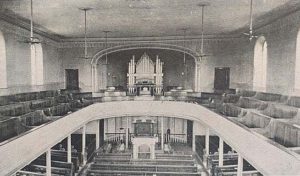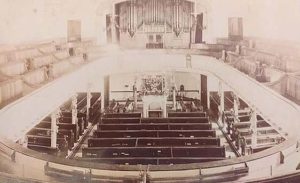
Camborne is a town in Cornwall. This profile of Camborne Centenary Wesleyan Chapel has been compiled by David Thomas.
 This photo dates from around 1880 and shows the chapel as originally constructed in 1839 with no portico or central doorway. The words in the gable say ‘chapel’.
This photo dates from around 1880 and shows the chapel as originally constructed in 1839 with no portico or central doorway. The words in the gable say ‘chapel’.
 This picture is from about 1903 and shows the front after its late 1880s alterations. The windows have been gothicized and a central doorway and porch have been added. The words in the gable now say ‘church’ incidentally while the side doorways provide gallery access.
This picture is from about 1903 and shows the front after its late 1880s alterations. The windows have been gothicized and a central doorway and porch have been added. The words in the gable now say ‘church’ incidentally while the side doorways provide gallery access.
The local youngsters today call this the pink church or the pink chapel, because of the colour with which it is currently painted. Older Cambornians of course refer to it as ‘Centenary’ but its correct name when built in 1839 was Centenary Wesleyan Chapel. It was called Centenary because it commemorated the 100th Anniversary of the conversion of the Wesley brothers, John and Charles, at Whitsuntide 1738.
There is a more practical reason also why this chapel was constructed. Twice during the 1830s, in 1831 and again in 1839, there were great local religious revivals amongst the Wesleyan Methodists, leading to literally hundreds of converts. This meant that Camborne Wesley Chapel, itself constructed in 1828 with seats for 1250, was too small to accommodate all those who wished to attend religious worship. Centenary was therefore built as an overflow Wesleyan chapel to Wesley and in its early days they had close links, sharing the same Sunday School committee. The new chapel could seat 800 worshippers.
Centenary also has a burial ground and at one time to be buried in it you had to be a member of either Wesley, Centenary or Tuckingmill Wesley chapels.
Centenary also had close links with the Holman foundry, with the large burial vault of that family situated in its cemetery. Many worshippers at Centenary also worked at Holman’s works.
Centenary had a fine musical tradition and of course the late Miss Lilla Miller, aka Mrs Rosewarne, was a Centenary stalwart. Today it houses the popular Camborne Music Festival and is an active church.
 This photo shows the interior of the Centenary Wesleyan chapel in the very early years of the 20th century and prior to the installation of a much larger pipe organ by Conacher of Huddersfield in 1904. If one looks very quickly at the picture the chapel interior bears a great deal of architectural similarity to that of Camborne Wesley in the early days with its orchestra archway, mahogany box pulpit with room only for the preacher and communion rail behind the pulpit in what is known as the ‘City Road’ style of Methodist architecture, based upon the layout of the interior of Wesley’s chapel in City Road, London. Behind the communion rail to the left of the pulpit there is a pedestal baptismal font. Gas lighting jets hang from the roof. On the rear wall behind the communion table are the Creed, Lord’s Prayer and Ten Commandments, echoing the arrangements of Anglican reredoses of the later 17th and 18th centuries. Compare the marble one of 1761 in Camborne church today.
This photo shows the interior of the Centenary Wesleyan chapel in the very early years of the 20th century and prior to the installation of a much larger pipe organ by Conacher of Huddersfield in 1904. If one looks very quickly at the picture the chapel interior bears a great deal of architectural similarity to that of Camborne Wesley in the early days with its orchestra archway, mahogany box pulpit with room only for the preacher and communion rail behind the pulpit in what is known as the ‘City Road’ style of Methodist architecture, based upon the layout of the interior of Wesley’s chapel in City Road, London. Behind the communion rail to the left of the pulpit there is a pedestal baptismal font. Gas lighting jets hang from the roof. On the rear wall behind the communion table are the Creed, Lord’s Prayer and Ten Commandments, echoing the arrangements of Anglican reredoses of the later 17th and 18th centuries. Compare the marble one of 1761 in Camborne church today.
 This postcard view shows the interior of the chapel decorated for the Harvest Festival in September 1911. The decorations on the pulpit and gallery pillars are rather restrained in comparison to what was usually more common at the time, i.e. a profusion of fruit, vegetables and foliage. The new larger organ, with beautifully stencilled coloured pipes, installed seven years previously, makes an appearance. The floor of the chapel is crowded with pews, there even being two pews facing inwards on each side of the pulpit. With large Sunday congregations they had to accommodate as many persons as possible. In recent years the downstairs pews have been removed and chairs substituted. The pulpit was replaced by a much larger rostrum during the chapel’s 1939 renovations.
This postcard view shows the interior of the chapel decorated for the Harvest Festival in September 1911. The decorations on the pulpit and gallery pillars are rather restrained in comparison to what was usually more common at the time, i.e. a profusion of fruit, vegetables and foliage. The new larger organ, with beautifully stencilled coloured pipes, installed seven years previously, makes an appearance. The floor of the chapel is crowded with pews, there even being two pews facing inwards on each side of the pulpit. With large Sunday congregations they had to accommodate as many persons as possible. In recent years the downstairs pews have been removed and chairs substituted. The pulpit was replaced by a much larger rostrum during the chapel’s 1939 renovations.
 Unknown date: Camborne Centenary Choir Quartet (Photo courtesy of Roy Blewett)
Unknown date: Camborne Centenary Choir Quartet (Photo courtesy of Roy Blewett)
